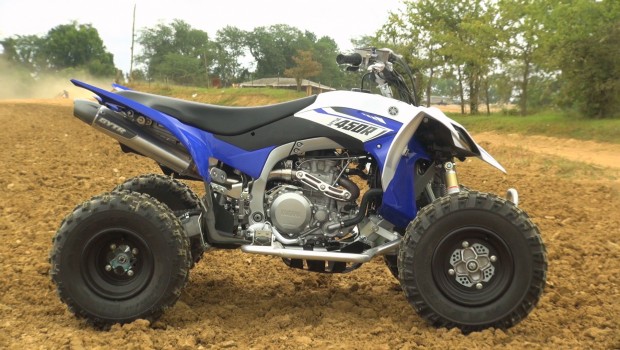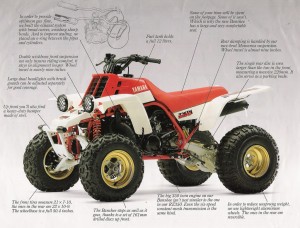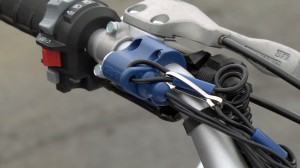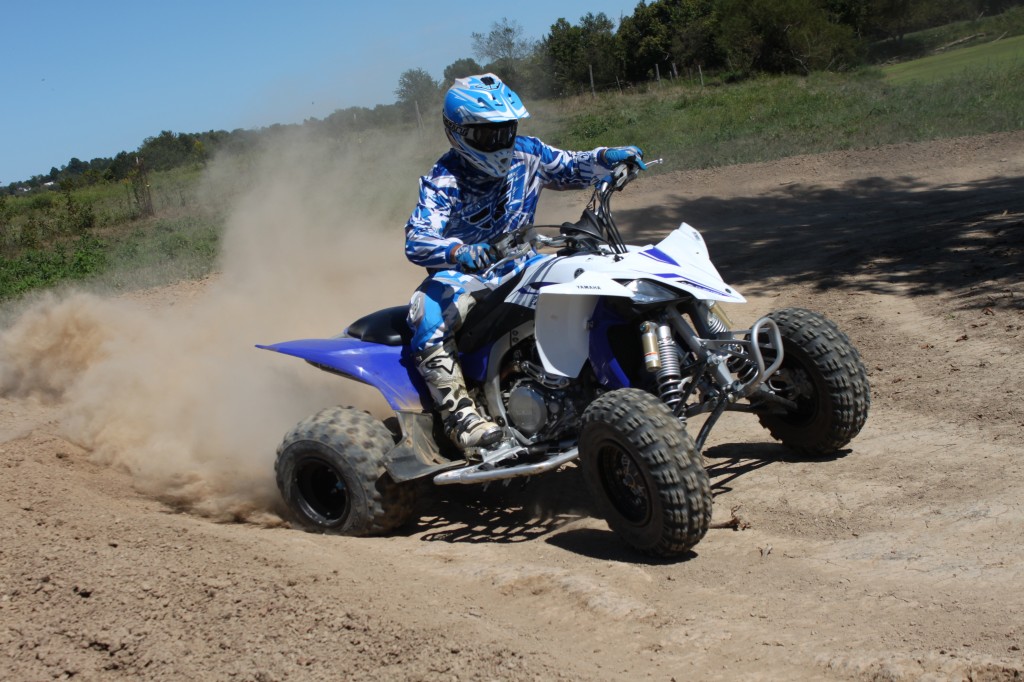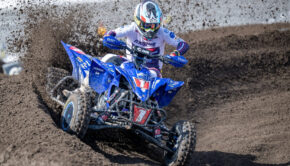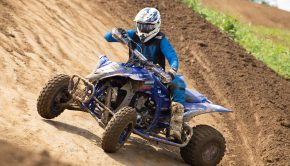Yamaha YFZ450R GYTR Budget MX Racer Project Test: with VIDEO
A dealer built race machine that will break the competition, not the bank.
While they didn’t build the first high-performance four-wheeler 30 years ago, no other manufacturer has shown the level of commitment to the sport ATV market as Yamaha, offering as many, or more, sport models than any other manufacturer since the late 1980s!
When four-wheeled ATV racing began, in 1984, many participants went down to their local dealership, purchased a new machine, added a small handful of accessories from the parts department, went out and raced competitively. When the 250cc two-strokes went away at the end of the 80s, innovation was handed solely to smaller aftermarket companies and the price of building a competitive machine skyrocketed.
The arrival of the high-performance four-strokes in 2003 and 2004 were supposed to drive down the price of racing. With a modest investment in a slip-on exhaust and new jets for the carburetor, the original YFZ 450 produced nearly 50hp. Accustomed to spending big money to make their machine’s fast, many competitors couldn’t accept that Yamaha had delivered a race-ready engine from the factory. Excessive motor mods didn’t make most racers faster; it did, however, make their engines less reliable and drove up the cost of competing.
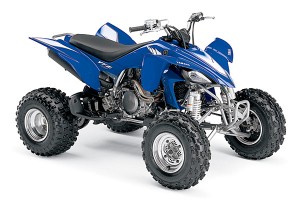
Back in 2004 and 2005, the new four-stroke’s 46in. width left them better suited for trail riding. Racers were forced to spend anywhere between $2,500 and $4,000 on chassis and suspension parts to widen their machines to the nearly 50-inch width considered ideal for motocross.
While their engines seemed focused for the rack, the new four-stroke’s 46in. width left them better suited for trail riding. Racers were forced to spend anywhere between $2,500 and $4,000 on chassis and suspension parts to widen their machines to the nearly 50-inch width considered ideal for motocross.
Enter the YFZ 450R
The totally redesigned 2009 YFZ 450R featured a motocross appropriate width of 48.5 inches, in addition to long-travel, highly adjustable suspension, so Yamaha riders no longer needed to spend thousands of dollars to widen their machines. The YFZR’s hybrid aluminum and steel chassis was designed to allow the engine to ride low and hold up to the demands of racing while remaining light. The brand new, fuel-injected engine offered a broader, smoother, power band with an emphasis on improved low-end power. The new engine’s lower end and cases were beefed up significantly to improve reliability under the extra demands of heavy modification.
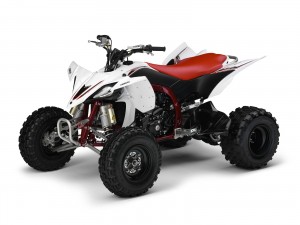
The totally redesigned 2009 YFZ 450R featured a motocross appropriate width of 48.5 inches, in addition to long-travel, highly adjustable suspension.
To keep manufacturing and importing prices in check while supporting the US economy, Yamaha moved assembly of the YFZ 450R to its Newnan Georgia Plant for 2014. They also made a small number of significant changes to the machine as well. They included opening up the cockpit by moving the front fenders forward and moving the rear fenders back and down. Part of the upper frame rails was covered with bodywork, softening the area where some riders were impacting their knees on previous models.
New suspension settings for 2014 were focused on improving small bump absorption without sacrificing bottoming resistance on the Kashima coated KYB shocks. The shocks feature high and low-speed compression, plus rebound adjustment. New Maxxis tires were designed specifically for the YFZR with a focus on improving ride quality while improving the machine’s cornering and sliding characteristics.
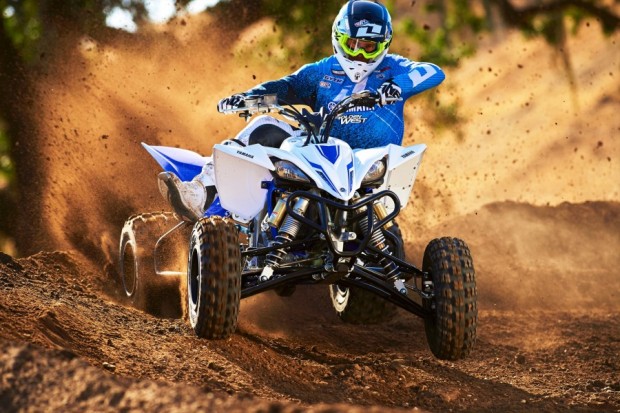
To keep manufacturing and importing prices in check while supporting the US economy, Yamaha moved assembly of the YFZ 450R to its Newnan Georgia Plant for 2014. They also made a small number of significant changes to the machine as well.
To further enhance the engine’s low-end hit and improve power across the board, Yamaha bumped the compression from 11.6 to 11.8:1, changed the cam profiles, and installed a new throttle valve. There’s a new ECU equipped with a new fuel map to complement the engine’s hardware updates. In spite of Yamaha’s valiant efforts to produce good power while meeting EPA restrictions, there’s still plenty of untapped potential in the engine that’s just a couple of bolt-on parts away.
A new A&S clutch uses a ramped design, forcing more pressure on the plates under acceleration, while using less springs for a 25% lighter pull. The clutch is designed to allow a level of slippage when the throttle is chopped, creating less engine braking for better suspension performance through braking bumps without pulling in the clutch.
Dealer Built Racer
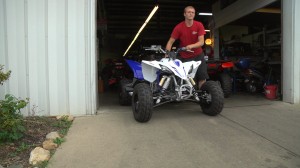
With Yamaha offering a full line of GYTR performance accessories, many Yamaha dealers stock the performance accessories needed to make your machine race legal and unrestricted without affecting the factory warranty.
Having tested the 2014 YFZ 450R, we can tell you that stock sport ATV performance is at an all-time high, but is the YFZR good enough to go from the dealer on Saturday to the podium on Sunday? To find out, we went to our local Yamaha dealership, picked up a brand new YFZ 450R, and requested that they install the parts to make it race-ready. Our machine moved from the showroom to the service department where they installed the necessary upgrades to make our machine race legal and eliminate the EPA restrictions that hold back the engine’s full potential in stock trim.
The Modifications
With Yamaha offering a full line of GYTR performance accessories, many Yamaha dealers stock the performance accessories needed to make your machine race legal and unrestricted without affecting the factory warranty.
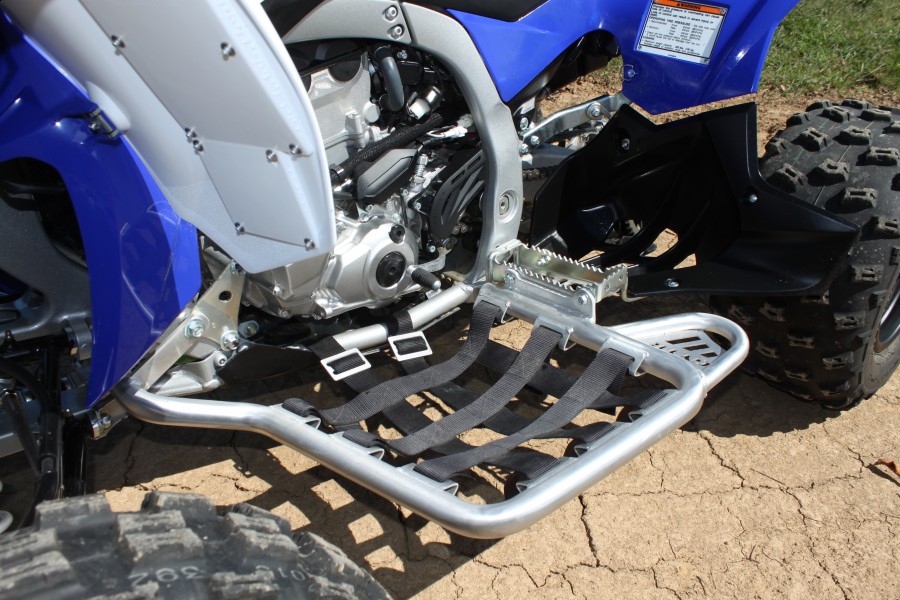
The first thing our dealer did was make the machine race legal by installing a set of GYTR nerf bars and tether kill switch.
The first thing our dealer did was make the machine race legal by installing a set of GYTR nerf bars and tether kill switch. Yamaha offers fancy nerf bars with adjustable height pegs and built-in heel guards; however, the YFZR’s stock pegs are super wide and comfortable. With light factory heel guards already installed, we decided to go with GYTR’s less expensive set of traditional style nerf bars. They cost less, fit well, and are all you need to go racing. The GUTR kill switch shuts the engine down should you become separated from the machine and simply plugs in with no need to cut and splice wires.
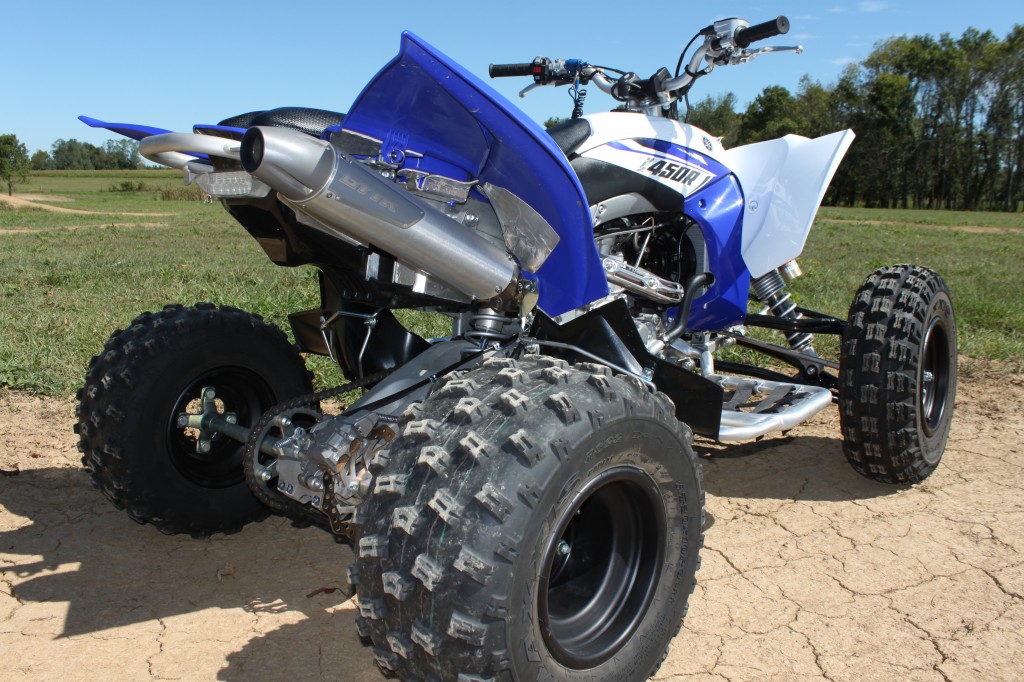
the restrictive stock exhaust was replaced with a GYTR slip-on exhaust which is designed to boost midrange and top-end power, while meeting the ATVA’s 99db sound limit
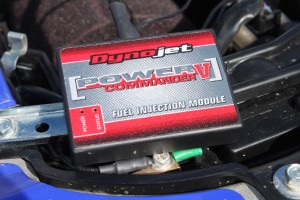
The Power Commander allows you to richen up the fuel mixture to complement the intake and exhaust changes.
Next, the restrictive stock exhaust was replaced with a GYTR slip-on exhaust which is designed to boost midrange and top-end power, while meeting the ATVA’s 99db sound limit. We then ditched the sitbox lid for a freer flowing intake and had the dealer install a Dynojet Power Commander V fuel system controller. The Power Commander allows you to richen up the fuel mixture to complement the intake and exhaust changes.
Track Test
Test Location:Haspin Acres, Laurel Indiana
After a couple hours at the dealer, we loaded up our now race-ready YFZ 450R and took it to Haspin Acres, a motocross and ride park, located in Laurel, Indiana, that has been hosting ATV racing since the three-wheeler days. To truly evaluate the competitiveness of our lightly modified YFZ 450R for racing, we acquired the help of Aaron Meyer, a racer with 14 years experience who cut his teeth racing at Haspin Acres, went on to win multiple national championships, and raced up to the Pro-Am and Pro level.
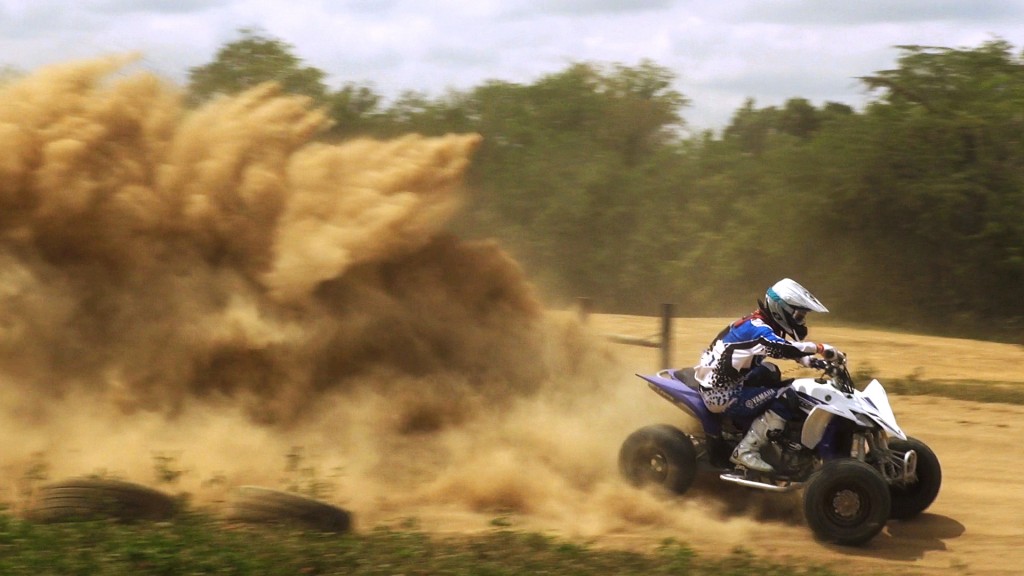
The machine’s revised ergonomics, low 31.9in. seat height, 1 1/8 in. handlebars, adjustable bar clamp, adjustable brake lever, and massive foot pegs provide a cockpit layout ideal for attacking the track.
Despite having taken some time off, Aaron was quickly picking up speed and putting in some fast laps on the YFZR. The machine’s revised ergonomics, low 31.9in. seat height, 1 1/8 in. handlebars, adjustable bar clamp, adjustable brake lever, and massive foot pegs provide a cockpit layout ideal for attacking the track.
With 9.8 inches of suspension travel up front and 11 inches out back, the YFZ 450R offers the most wheel travel available in the 450cc class. At 165 pounds, Aaron backed the shocks’ low-speed compression damping adjusters out a couple of clicks front and rear, then pretty much left them alone. Bottoming resistance isn’t an issue on the YFZR, making up for Aaron’s occasional mistake of overshooting jumps. The shocks were equally at home pounding deep rollers and blitzing through two foot deep whoops where most modern OEM high-performance shocks come up short in braking and acceleration bumps, and square-edged holes. In our 2010 450cc Motocross Shootout, the YFZ 450R’s suspension came out on top due to its superior all-around performance. The 2014 suspension updates made the YFZR’s ride plusher in the chop without sacrificing its big hit prowess.
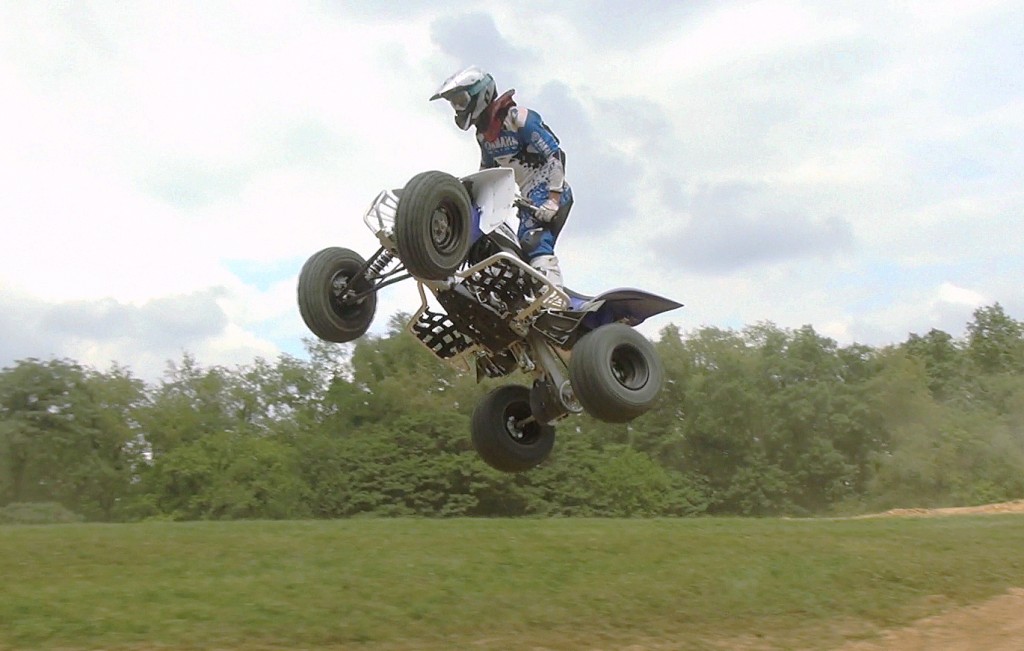
In our 2010 450cc Motocross Shootout, the YFZ 450R’s suspension came out on top due to its superior all-around performance. The 2014 suspension updates made the YFZR’s ride plusher in the chop without sacrificing its big hit prowess.
Motocross machines have used 18in. rear tires for decades. Aaron felt that the smoother rolling characteristics and slightly higher ground clearance provided by the YFZ’s 20in. Maxxis tires, could make them a good choice for racing on sandy or deeply tilled tracks, which often become very choppy and can develop ruts in the turns. The YFZR’s 48.5-inch width and low ride height allow you to drive the machine hard into and out of corners. Two-wheeling never seemed to be an issue on Haspin’s hard-packed, silty-bermed turns. A 50in. wheelbase and superb stock suspension keep the machine tracking straight on fast, rough sections.
The engine really comes alive on the YFZR with the slip-on GYTR exhaust and Power Commander V. With the airbox lid on, the machine ran flawlessly and enjoyed a healthy power increase over stock. Removing the airbox lid added significantly more midrange and top-end power, at the expense of the engine wanting to flare out when the throttle was chopped heading into turns. It turns out that the Power Commander V comes with a map designed to optimize power with the YFZ 450R’s stock exhaust and the airbox lid on. We uploaded a map from Dynojet’s map dataset, which comes with the Power Commander, written for the full GYTR exhaust and GYTR filter, which eliminated virtually all of the low-end hesitation. A little fine-tuning with a lap top computer and Dynojet’s included software and we should have it dialed in perfectly. With the GYTR map, the YFZR pulled hard in the lower RPMs, in addition to providing the big gain in midrange and top-end we first noticed when we removed the airbox lid. Make sure you update to the correct map before you take your YFZ 450R out for its first race, and you will have a machine that will be easier to ride and fast enough to blow away a stock machine.
The brakes are phenomenal right out of the box, offering plenty of power for late braking into corners. Most riders won’t need more power than the stock binders provide and already being wide means you won’t need to spend money on extended brake lines to accompany the wider a-arms Yamaha already provides. Other details such as grease fittings, an easy-to-use eccentric chain adjustment system, and no-tool quick release fasteners for the bodywork makes maintenance quicker and easier for competitors.
The Bottom Line
Unless your local race happens to be the A, Pro-Am, or Pro Class at an ATV National, TQRA, NEATV, Quad X Series, or other major regional motocross series, we believe the YFZ 450R offers nearly all the machine most local racers need. Sure, you would benefit from a steering stabilizer, or perhaps a different tire setup to meet the demands of a specific track. The Kashima coated KYB shocks offer very good component quality and lots of adjustment. Like modern dirt bike suspension, they could be made even better with custom springs and valving to suit a specific rider; however, if you simply take the time to adjust them for your weight and riding style, most riders could easily compete at the local level with the stock shocks.
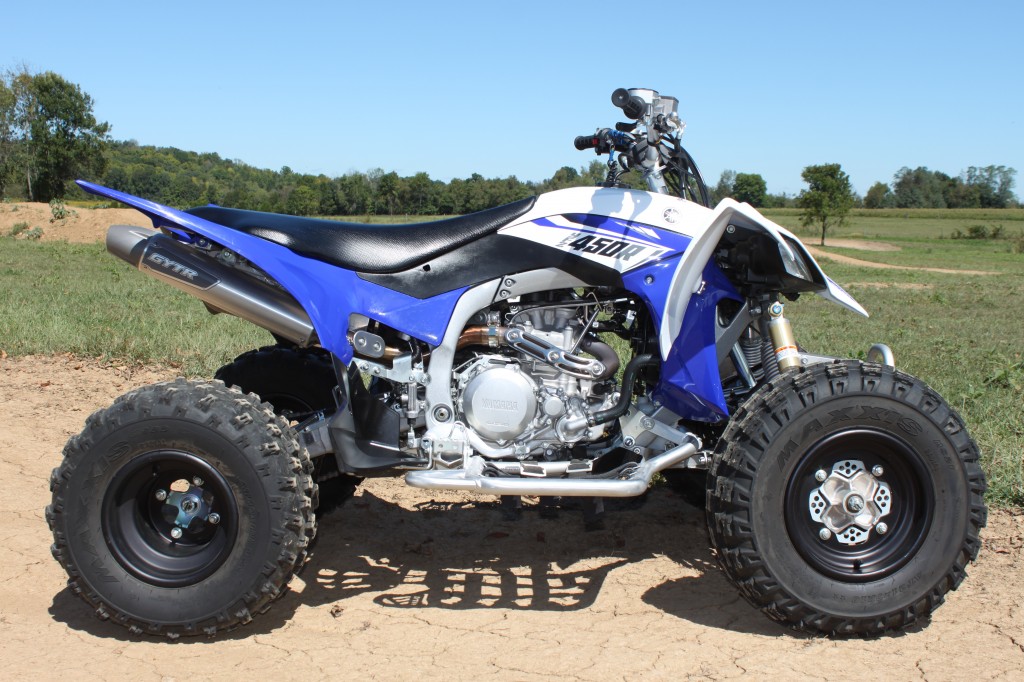
ATV Racing is still one of the most affordable forms of motorsports you can get involved in. For under $10,000 Aaron felt that our Dealer Built YFZ 450R racer with the minimum in accessories provided all the performance needed to be competitive at most local tracks.
With the GYTR exhaust and Power Commander V installed, the engine will shred berms, attack jumps out of turns, clear most any jump most riders will have the courage to attempt, and lay the smack down on slower, or easily intimidated, competitors.
ATV Racing is still one of the most affordable forms of motorsports you can get involved in. For under $10,000 Aaron felt that our Dealer Built YFZ 450R racer with the minimum in accessories provided all the performance needed to be competitive at most local tracks. You can always spend more money than the guy next to you on the line, but you aren’t going to win at motocross if you don’t practice, aren’t in good shape, and don’t have heart, and you can’t buy that.
For more information on the three consecutive national championship winning YFZ 450R and Yamaha’s full line of GYTR accessories, log onto www.yamaha-motor.com
2014 YFZ450R: $8,799
GYTR Slip-on Exhaust: $363.95
Dynojet Power Commander V: $368.95
GYTR Nerf Bars: $233,44
GYTR Kill Switch: $41.49
Price as Tested: $9806.83

